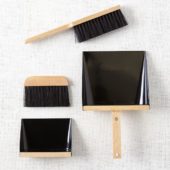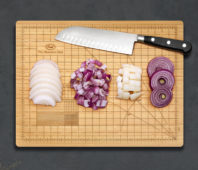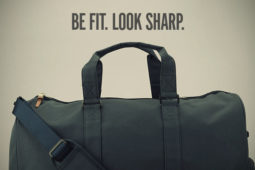ManMade Top Ten: Non-Powered Workshop Tools

I do indeed love the sights, sounds, and smells of a razor-sharp sawblade ripping through a two-inch block of hard maple, or a router-bit whizzing at 23,000 rpm creating a perfect 1/4″ roundover.
But, for as much as I embrace the strength and speed of power tools, I find myself spending even more time with those tools that DON’T require ear plugs. Of course, you need hammers and screwdrivers and wrenches, but here’s a list of ten items you can find in your hardware store that’ll help you turn out great work, without the need for batteries or electricity.
1. All Sorts of Clamps. There’s an old saying in the woodworking community…”You can never have too many clamps.” [It’s true. Do a Google search.] And even if you’re not into fine woodworking or cabinet-making or finish carpentry, a healthy collection is a super useful thing to have around. Besides holding stuff together, clamps can help keep all kinds of things still and secure so they don’t slip, and can keep your hands far away from sharp, spining metal. A collection of two-four pipe clamps, a few pair of c-clamps, some short bar clamps, and a few spring clamps will be just what you need for most projects.
![credit: White Oak Art [https://www.flickr.com/photos/whiteoakart/471538245/] created at: 2010/02/04](https://s3.amazonaws.com/manmadediy-uploads-production/photos/130/471538245_2214431561.jpg)
2. Calipers. I’m amazed about how useful I find my set of fractional dial calipers. Their best use is measuring two symmetrically opposing sides – like the outside of three-dimensional object, such as a diameter of a cylinder or the thickness of a item. But they’re equally useful for measuring internal distances, such as the size of a cavity or the empty space of container. I keep mine right on top of the workbench (in their case, of course), and grab them more often than any other micro-measuring tool. They’re one of those things you don’t know you need until you’ve got them, and you use it all the time.
3. Combination Square. On the other side of the measuring and scribing coin, a combination square is a perfect compliment to a pair of calipers. It’s a ruler, an adjustable square, and an adjustable 45-degree angle all in one. I use my on nearly every project, from sewing to paper crafts to hardcore wood mangling. Don’t scrimp on this one – spend the extra cash on one you’re sure will stay square and straight, and you’ll never regret it. Promise.
4. Vise Grips [Locking Pliers]. When there’s nothing else that can get that darn thing out, or make it come apart, reach for a pair of Vice Grips. They have adjustable jaws that lock in place, and nothing but the included release lever can drive them apart. They’re also great for securing items you don’t want to move, or for grasping metal items that could get hot due to friction, or direct application of heat, like a blow torch.
5. Bench Vise. When working on a project, sometimes you need a helping hand, and a bench vise is just that. It’s like a heat-proof, super strong best friends that will let you smack him with a hammer and who promises to never let go until you tell him. A heavy duty 4″ model can be had for under $40.00. If you find yourself doing a lot of fine woodworking, a woodworker’s vise (as opposed to a machinist’s vise) would suit you as well. Though if you find yourself doing alot of fine woodworking, you probably already knew that.
![credit: Tom Hannah [https://www.flickr.com/photos/24978482@N04/4232391526/] created at: 2010/02/04](https://s3.amazonaws.com/manmadediy-uploads-production/photos/134/4232391526_9e4935a150.jpg)
6. Bench Chisel Set. Sure, there are machines that can do what a traditional chisel does with much less effort, but sometimes it’s just not worth the set up. Often, it’s easier to grab a chisel and mallet, and get the job done. Quality starter sets can be had for around $50.00, and sometimes, there’s simply nothing better for the job.
7. Coping Saw. A coping saw contains an adjustable blade that can be used to make curved and intricate cuts. With the appropriate blades, it can cut wood, aluminum, steel, foam, and plastic. And, they’re like $10.00, so it’s wise to keep one on hand even if you have an electric jig- or bandsaw.
![credit: Akeeh [https://www.flickr.com/photos/akeeh/3692079422/sizes/o/] created at: 2010/02/04](https://s3.amazonaws.com/manmadediy-uploads-production/photos/138/3692079422_dcb2d757c8.jpg)
8. Proper safety gear. Your parts are too important to not protect, and though I wish I could include a sweet tool here that does awesome stuff, your safety matters more. No project should be approached without safety glasses, and often with a dusk mask or ventilator, and ear plugs. Heck, I even use safety glasses with my sewing machine. A few pairs of proper work gloves and a box of medical latex/rubber gloves will also keep your digits safe and unstained.
9. A nice, long straight-edge. Everyone from cabinet-makers to gourmet chefs know the importance of keeping things on the straight and square. Sewers have their yardsticks, drafters have their t-squares, and architects their fancy rulers. Whatever you choose, store it safely to keep it in top shape, so it can do what it was intended to do. My favorite straight edge is this clampable one from Rockler, which contains jaws to help you stay square. Plus, it works perfectly as a fence for circular saws and routers, and the numbers are really easy to see.
![credit: Inspire Creations [https://www.flickr.com/photos/ianfarrugia/1283619285/sizes/m/] created at: 2010/02/04](https://s3.amazonaws.com/manmadediy-uploads-production/photos/142/1283619285_94c3c275e2.jpg)
10. A sturdy work bench. Lastly, no matter what your craft, everyone needs a nice level, strong place to work. Make yours as big as you can without getting in the way. Even if you don’t need the workspace now, you will. Think of it like a desk space in your office, or countertops in the kitchen.
What’s in your top ten tool box? Let us know in the comments below.

![credit: Erasmus T. [https://farm5.static.flickr.com/4070/4247929099_af89d5edea.jpg] created at: 2010/02/04](https://s3.amazonaws.com/manmadediy-uploads-production/photos/126/4247929099_af89d5edea.jpg)








